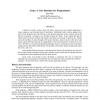Free Online Productivity Tools
i2Speak
i2Symbol
i2OCR
iTex2Img
iWeb2Print
iWeb2Shot
i2Type
iPdf2Split
iPdf2Merge
i2Bopomofo
i2Arabic
i2Style
i2Image
i2PDF
iLatex2Rtf
Sci2ools
USENIX
1994
1994
Acme: A User Interface for Programmers
A hybrid of window system, shell, and editor, Acme gives text-oriented applications a clean, expressive, and consistent style of interaction. Traditional window systems support interactive client programs and offer libraries of pre-defined operations such as pop-up menus and buttons to promote a consistent user interface among the clients. Acme instead provides its clients with a fixed user interface and simple conventions to encourage its uniform use. Clients access the facilities of Acme through a file system interface; Acme is in part a file server that exports device-like files that may be manipulated to access and control the contents of its windows. Written in a concurrent programming language, Acme is structured as a set of communicating processes that neatly subdivide the various aspects of its tasks: display management, input, file server, and so on. Acme attaches distinct functions to the three mouse buttons: the left selects text; the middle executes textual commands; and t...
| Added | 02 Nov 2010 |
| Updated | 02 Nov 2010 |
| Type | Conference |
| Year | 1994 |
| Where | USENIX |
| Authors | Rob Pike |
Comments (0)

